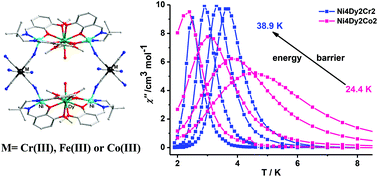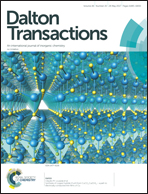Metallocyclic Ni4Ln2M2 single-molecule magnets†
Abstract
We herein report the synthesis, crystal structure and magnetic properties of nine new heterotrimetallic complexes. [Ni(Me2valpn)] (H2Me2valpn = N,N′-bis(3-methoxysalicylidene)-2,2-dimethyl-1,3-diaminopropane) was used as the precursor to construct phenoxo-bridged [Ni2Ln]3+ (Ln3+ = Dy, Tb, Gd and Y) species that were respectively connected by two [M(CN)6]3− (M = Cr, Fe or Co) anions to form octanuclear cyclic complexes, i.e. {[Ni(Me2valpn)]2Ln(H2O)M(CN)6}2 in which Ln = Y, Gd, Tb and Dy and M = Cr, Fe or Co (1–9). Each of the complexes contains many lattice-bound molecules of solvation. The Ni(II) ions are penta-coordinate, while the Ln(III) ions are nine coordinated with a muffin geometry. The fitting to the χmT vs. T curves of complexes 6–9 gave the parameters of JNiCr = 11.82 cm−1, JNiGd = 0.94 cm−1 and g = 2.04 for complex 6, JNiFe = 10.58 cm−1, JNiGd = 1.24 cm−1 and g = 2.03 for complex 7, JNiCr = 9.4(1) cm−1, zJ′ = −0.050(2) cm−1 and g = 2.06(1) for complex 8 and JNiFe = 4.9(7) cm−1, zJ′ = −0.35(2) cm−1 and g = 2.24(1) for complex 9, respectively. The dynamic magnetic investigations demonstrate that complexes 1–5 display single-molecule magnet properties with an effective energy barrier (Ueff) of 38.9 K (1, M1 = Dy, M2 = Cr), 37.2 K (2, M1 = Dy, M2 = Cr), 24.4 K (3, M1 = Dy, M2 = Co), 21.9 K (4, M1 = Tb, M2 = Cr) and 29.6 K (5, M1 = Tb, M2 = Fe), respectively. Complex 1 shows the highest energy barrier among the octanuclear [Ni4LnM2] (Ln = Dy or Tb, M = Fe, Cr, Co or W) system. Although the [Ni4Dy2Cr2] complexes have Ueff higher than that of [Ni4Dy2Fe2], complex [Ni4TbCr2] shows lower Ueff than that of [Ni4TbFe2]. The results indicate that besides the M–C![[triple bond, length as m-dash]](https://www.rsc.org/images/entities/char_e002.gif) N–Ni magnetic coupling the lanthanide ions can significantly affect the magnetic performances of heterotrimetallic SMMs as well. Moreover, the SMMs are achieved when diamagnetic Co(III) was substituted by paramagnetic Cr(III) or Fe(III) in the [Ni4Tb2 M2] system, suggesting that the trimetallic strategy is effective in the construction of new 3d–4f SMMs.
N–Ni magnetic coupling the lanthanide ions can significantly affect the magnetic performances of heterotrimetallic SMMs as well. Moreover, the SMMs are achieved when diamagnetic Co(III) was substituted by paramagnetic Cr(III) or Fe(III) in the [Ni4Tb2 M2] system, suggesting that the trimetallic strategy is effective in the construction of new 3d–4f SMMs.



 Please wait while we load your content...
Please wait while we load your content...